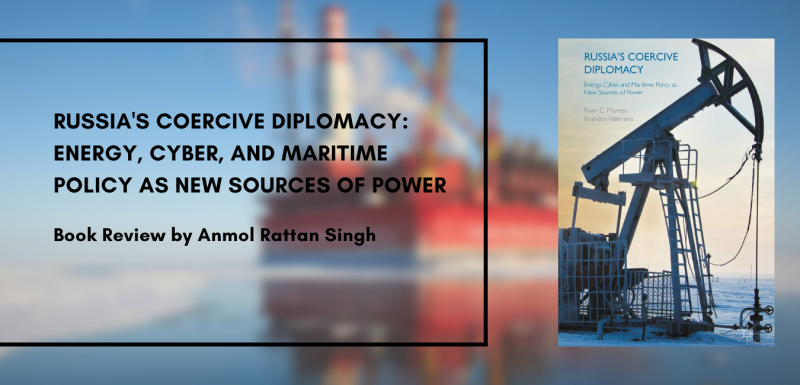[Book Review] Russia’s coercive diplomacy: energy, cyber and maritime policy as new sources of power

How are Russian foreign policy practices impacting the course of peace and stability in Eastern Europe, Caucasus and Central Asia? How is Russia utilizing its large hydrocarbon endowments as a coercive gear? What has been the trajectory of Russia’s cyberwarfare? What is Russia’s maritime Arctic policy? In their timely and fascinating book, “Russia’s Coercive Diplomacy: Energy, Cyber and Maritime policy as New Sources of Power” Ryan Maness and Brandon Valeriano examine these four vital issues through a combination of area studies and quantitative analysis.
The Russian Federation has managed to keep its place as one of the key players and challengers in the post-Cold War international order. Bordering – East and Central Asia, Europe, the Middle East, and North America, Putin’s Russia is asserting to claim a major independent-power status internationally. As a result, its foreign policy has become much more assertive in recent years. It surprised many with its 2008 war in Georgia, its 2014 seizure of Crimea and intervention in eastern Ukraine, and its 2015 deployment of forces in the Syrian civil war. [1]Today, when Russia threatens to invade Ukraine with a large military system near the Russian-Ukrainian border, it is necessary to explore the context and nature of this Russian behaviour.
Although the means of engagement and influence adopted by Russia undergo a critical enquiry every so often, their underlying compositions and patterns have not received much attention. The book, “Russia’s Coercive Diplomacy: Energy, Cyber and Maritime policy as New Sources of Power” by Ryan Maness and Brandon Valeriano is thus a good beginning in this direction. The uniqueness of this book emanates from its ‘salience-based’ examination of foreign policy actions. The authors believe that foreign policy scholars often fail to examine both the sources of actions and the successes of foreign policy objectives in light of their goals. Blanket theories of foreign policy processes are empty without an examination of the linkage between domestic demands and opinions, on one hand, and external options and constraints, on the other. Therefore, to fill this gap, the authors have structured their analysis of the Russian foreign policy along these two lines. Further, the authors’ targeted focus on situational factors, such as rivalries, domestic public opinions and salience of issues under consideration, create a unifying framework to examine these themes and give the readers a much richer understanding of their research.

The book is structured around historical examination and predictive analysis, providing both theoretical and quantitative insights. It has eight central chapters covering four specific themes, namely: US-Russia rivalry in post-soviet space; Russia in Cyberspace; Russian Energy diplomacy; and Russian Foreign policy in the Arctic. The theoretically focused introductory chapters led by a brief introduction about the economic transformation of Russia and its current geopolitical identity set the context of the book. Significance is also placed on elucidating the examination methods and components that help readers to systematically uncover each issue. Most fundamentally, the authors examine the Russian foreign policy decisions and undertakings by comparing and contrasting the contributions of various IR scholars like Nygren, Vasquez, Tsygankov and Berryman. These contributions render the reader a holistic understanding of the diverse foreign policy perspectives. At the end of the second chapter a brief explanation of each arena/issue, and why each arena is important in context to the Russian foreign policy, establishes an outlook for the upcoming chapters.
The third chapter in the book argues around the development of – rivalry termination theories and policies. It explains how the rivalry between Russia and US has shifted in scope to a reduced reliance on conventional forms of power. The US-Russian rivalry demonstrates the enduring nature of historic animosity. It continues to be the principal rivalry for both states and has only changed from a geopolitical rivalry to a regional policy rivalry, with an intrinsic potential of a quick escalation. The authors have approached the problem in three ways. Firstly, they have explained the evolution of the US-Russian rivalry. Secondly, they have presented a theoretical perspective on rivalry termination. Lastly, they have used public opinion theories and statistics to assess the foreign policy actions undertaken by both states.
Cyberspace is generally regarded as a new dimension of conflict, and Russia is widely considered a heavyweight in cyber capabilities. It is also one of the most active users of cyber power. The fourth chapter of this book critically analyzes this claim by examining Russia’s coercive cyber-warfare strategies. Through empirical data, assessment of institutional capabilities, and specific case studies, this book proves that Russia, even when it is potentially the most dangerous state in cyberspace, prefers to limit its cyber use and rather indulges in traditional power politics tactics. This statement has been backed by the authors with the help of various case studies showing how Russia has used its cyber capabilities only against three states with all other cyber actions being undertaken by non-state, individual actors.

Furthermore, in chapters five and six the authors delve into the most controversial topic – Energy politics. Russia is conventionally known for its coercive energy policy. Economic statecraft is utilized in this area by Russia because it allows Russia to rein in the governments of its former empire by rewarding or punishing states by adjusting the price they pay for Russian natural gas. The readers significantly benefit from the geographical division the authors have adopted for a better-structured approach. The regional grouping into the Caucasus, Central Asia and the left-over post-soviet space is deliberately done to demonstrate how Russian indulgence and salience of a specific state varies with the region it is in. For instance, the Caucasus region has a high energy salience due to the presence of the United States in the region. Moreover, Russian public opinion has been clear in its approval of the use of coercive energy tactics on the states in this region. Central Asia, on the other hand, is found to have low energy salience. These states due to their engagement in the pro-Russian Shanghai Cooperation Organization, and the Eurasian Economic Community happen to enjoy low salience for Russia. Another insight the book provides is in the field of pipeline politics. The authors show how Russia is building pipelines to circumvent transit countries in post-soviet space and how at the same time many former USSR states have attempted to diversify their energy suppliers.
Arctic politics is a fresh topic and through its incorporation in the book, the authors have given the book an edge over other books around similar topics. The Arctic issue can be considered a regional issue pertinent to many great powers. This issue according to many IR scholars is still in its genesis stage. With the impact of global warming, the region is now fast becoming a contested space between Russia and other capable powers. Addressed in the seventh chapter, this issue is largely studied by using predictive assessments as no definitive case study exists to assess Russian behaviour in this region. Here, the authors identify and consider two areas of debate, namely; i. Natural resource exploration; ii. Operation and management of maritime routes in the Far North. They suggest that Russia might deal with these issues more pleasantly and optimistically than engaging in power politics and zero-sum games. Also, the authors, in this chapter examine public opinions and salience of this issue, among the Arctic Five states i.e., Canada, Denmark, Norway, Russia and the United States. The results of which show a tendency towards peaceful cooperation.
Given the book was written in 2015, the role of China as discussed in the book is limited to pipeline engagement in the Central Asian region. Also, a much larger focus has been laid on the US-Russian rivalry which in current times has taken the backseat due to the up-and-coming Sino-US rivalry. Loaded with graphical and tabular figures this book is an insightful text, providing a study of foreign policy by using Russia as the focal point. Given the three key elements of Russia’s power that Valeriano and Maness saw as central to its coercive diplomacy – energy export, cyber operations, and maritime power, the authors add a great deal to our understanding of the study of international relations and foreign policy behaviour. Overall, the book serves as an overview and introduction to the central issues confronting Russian diplomacy and opens vistas for foreign policy analysts to investigate upon. Valeriano and Maness indeed provide an excellent foundation for the consideration of public opinions and salience of issues as tools in de-escalating disputes.
[1] Russian Foreign Policy | Center for Strategic and International Studies (csis.org)


















